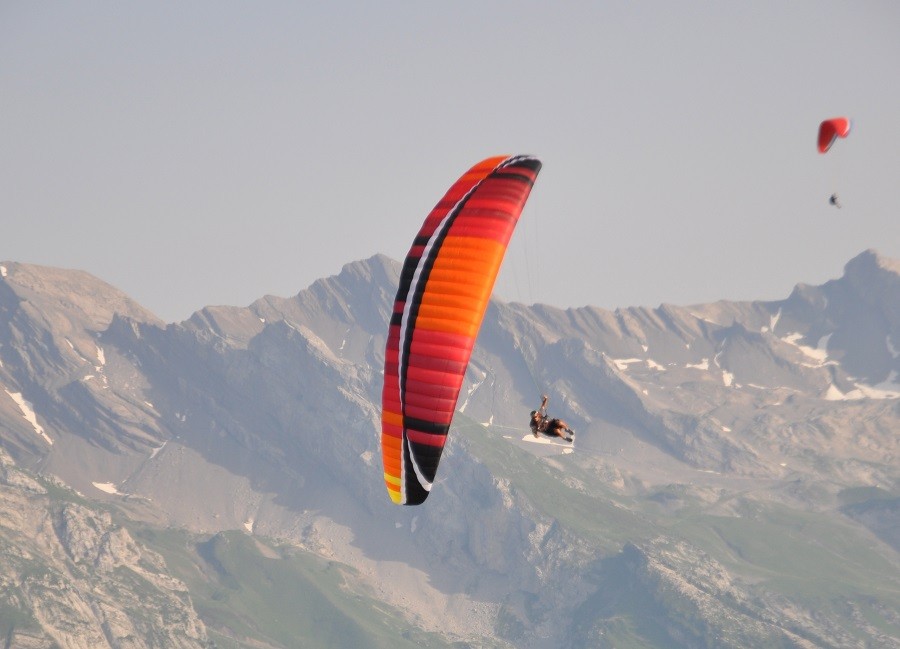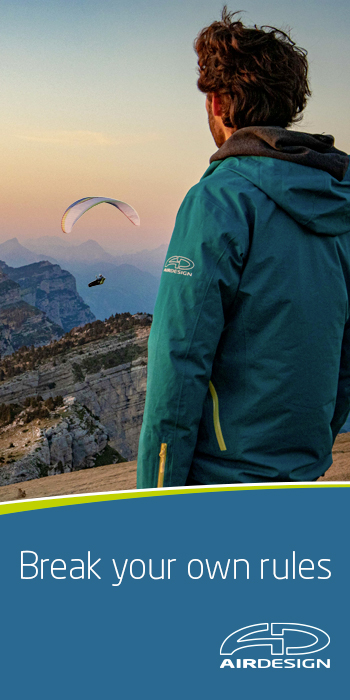
BGD Base (EN-B), tested by Cédric Nieddiu
On a regular basis Rock the Outdoor will be sharing with you a series of test reports on the latest gliders and harnesses, provided for us by Cédric Nieddiu, CERTIKA’s in-house test-pilot from Le Grand Bornand, France. The aim is not to make any comparative tests, but to provide a descriptive presentation and account of new equipment tried and tested by a professional. BGD has been in the news a lot recently with the success of their new glider, the Base, with it’s unique “Cord Cut Billow” technology and leading edge design. Curious as to what all the noise was about, we asked Cédric to take it for a spin or two, and this is what he came back with : BGD Base (EN-B), tested by Cédric Nieddiu
BGD Base, an different concept and design
“On unpacking the BGD Base, you immediately discover the dominant shark nose profile and leading edge which will most certainly take you by surprise. The aerofoil’s upper surface forms the prominent leading edge beyond the cell openings of the under surface. It is the most elaborate profile design I have yet seen. Taking a closer look one can only admire the intricate design that has gone into making this leading edge the most aerodynamic around at the moment. BGD has called this innovative technology the Cord Cut Billow: A concept design enabling the wing to be assembled without any creasing. The results are astonishing. For those of you who do not know of Bruce Goldsmith, he is the designer and test pilot of his own brand BGD, but also designer of the Black Magic wing, the Vodoo, the Xmx and Xxx; all wings which revolutionised our sport back in the day. His experience of designing performance wings is today transmitted through his own brand, BGD, and incorporated into his EN-B paraglider, the Base. The look and feel is almost identical to that of Airwave.

After having flown this wing for 20hrs I think it is fair to say that the BGD Base opens up a whole new ball-game for the Sports class by offering a surprising amount of performance and stability.
Lets take a look at the materials used to manufacture the wing: Dominico N30 on the upper surface and N20 on the under surface, with DFM D30 for the internal structure. Nothing has been spared as to the quality of lines used to reduce drag and improve glide performance, and the choice of combining sheathed and unsheathed lines has been purposely accounted for to reduce ageing, and increase resistance and the necessity to later retrim. This is where we find the continuity of Bruce’s knowledge and experience; Airwave always had a solid reputation for robust canopies, and the tests I was able to make on the Base confirm this reputation. For the solidity, BGD have chosen sheathed Aramid on the lower and intermediate lines and unsheathed Dyneema on the upper sections, limiting the fluctuations in tension caused over time. For those of you who are unsure of the difference, Aramid is very stable in dimension (length) but necessitates a thicker diameter than Dyneema, which itself, has a tendancy to shrink and not always in a homogoneous way.

The neatly finished risers have been made with handles enabling C-line piloting. Close-up, the quality of superior manufacturing is apparent in fine detail: high-end pulleys, anodised steel rings… nothing has been overlooked.
manufacturing happens in Sri Lanka and in view of the precision, is second to none

Internal sail tension for speed
From the first moments in-flight with the Base, the sensation is one of solidity felt from the wing’s internal structure. The shark nose profile can often give this impression, but here, we can really feel the inner strength. The second noticeable aspect is the trim speed. There is 2km/hr more than with other wings of the same certified EN-B category. In a nutshell, the BGD Base is faster at trim than the Ozone Rush 4, the Advance Iota and the Nova Mentor 4! We were able to obtain a constant 40km/hr with 92kg PTV (all-up weight). As for the glide ratio, the maximum variation of 10-10.5 in still air rivals even the high-end EN-B wings.

During my first test flight at Planpraz above Chamonix with a covered sky and a strong northerly wind at altitude. With a nearby group of pilots flying similar wings, the results were very apparent……

Maximum efficiency for the BGD Base in climbs
The BGD Base has a minimal descent rate with easy handling, which is not short of “genius”, even with the tricky flying conditions. This reminded me of 10 years ago at St Vincent les Forts when I watched Bruce Goldsmith turn in 0,1m/s thermals under a grey sky and I remembered asking myself how he did it. The following day, I discovered that Bruce had flown all the way back to Gréolières! I would like to believe here is a distinctive link between a pilot and a designer who is able to demonstrate this kind of skill.
Performance and pleasure with easy handling
We quickly understood that in minimal thermal conditions the Base is super-efficient, and in my opinion, the best in its category. However, the Base’s true strength lies in its turn efficiency, whether thermic or dynamic, in any type of conditions. It’s ability to remain in the core when thermaling communicates a sensation of pure comfort and safety.

Efficient on glide
At cloudbase, time for the transition. The overall sensation is of comfort and stability, particularly when flying with a pod-harness. In the horizontal position it is always crucial to limit the yaw movements of the harness in order to reduce drag. This stable position translates to an improved glide. The BGD Base absorbs turbulence without perturbing the trajectory. Using bar sends the glider to 55km/hr; a useful weapon when facing into wind or in the lee of the relief. Even though the Base offers a sensation of solidity, it remains nevertheless a paraglider and is still susceptible to collapse in certain configurations when using the accelerator, so it is important to retain a margin of security close to the ground of at least 200m.
The Base combines performance and adventure
Paragliders today are often categorised according to the function and faculty in terms of speed, glide performance, handling, weight range or manoeuvrability acrobaties.
The BGD Base at first glance is a wing destined for XC pilots wanting to fly distance. Having said that, it can also be enjoyed by soaring pilots as well as acro thrill-seekers. At the end of the flying day in Le Grand Bornand, we were blessed with soaring conditions giving us the opportunity to create our own mini wagga festival for several hours, whilst we enjoyed the playful aspects of the Base!

What weight range?
The easy handling of the Base comes from the sensation of tension in the canopy, which offers a degree of flexibility in each certified weight range, which is indeed a rarity. If you are looking for best compromise between forward speed and descent rate, position yourself between the 87 and 92kg PTV weight range which is recommended for the “M” size.
Outside the testing zone
As previously mentioned, we felt the considerable solidity in the sail. Often this tension translates to dynamic sensations beyond thermic flying. Here, we tested the full-stall, high brake input and the heli manoeuvre, where we felt we were dealing with a different wing altogether. The wing tips work together helping slow the wing down as soon as it recovers and dives. As with all performance wings, slim wing tips with reduced line length can create small cravats. These when they occurred were quickly released by a rapid and firm movement of the stabile line or by pulling on the line attached to the B’s. Watch out for spiral dives with the Base, as we found these to be reasonably engaged and necessitated a considerable amount of pilot input to exit from. This is typical feature with all performance wings as the centrifugal force increases with the heightened performance of the wing.
Conclusion
The BGD Base is a performance wing with a level of passive safety making it accessible to many pilots in its category. The Base produces honest feedback with regard to closures and asymmetric tucks, equally with full-stalls. However, it remains dynamic in spiral dives which require pilot input to exit and a certain level of pilot skill to master.
The Base does not need to be categorised as a pure performance glider. It is a wing which is generous in its ability and can offer pleasure to a wide range of pilots in a variety of conditions, given its speed and turn efficiency.
Generally speaking, the wing is a remarkably well-balanced all-rounder. There leaves little doubt that the Base will remain a “performance” reference in the EN-B category for many years to come.
Cédric NIEDDIU, for ROCK THE OUTDOOR

KNOW MORE
about “Cord Cut Billow” technology

Special cut of the leading edge panels. Cord Cut Billow (CCB) technology
Technology developed by BGD to improve the overall surface area, the stability and general performance of the wing: the upper-surface panels of the leading edge are shaped and cut along the straight of grain to ensure an optimised surface area of the cells. The reduction of creases in the material contributes to the improved shape of the ribs, which increases the overall strength.




Mark
Question about a comment made in your great review of the base. You say it ‘rivals even high end B gliders’. Are you suggesting it isn’t a high end B wing? It is marketed as such but perhaps it’s stability makes it feel like a lower (mid) B? As someone hoping to step up soon after 2 seasons/70 hours on an older A and not sure if a high B is a good move, I’d be happy to see more options safe enough for, and marketed as, a second wing. Thx.
Emma Casanova
Hi Mark, Thank you for your comment. Indeed the BGD Base is marketed as a mid-range ENB. Because of its performance it rivals the high ENB category, but the handling remains true to the mid range ENB wing.
Although Rock the Outdoor cannot make recommendations about which wing is the best choice for your personally, we would recommend that you contact BGD and ask for a demo to try before you contemplate a purchase. Happy flying and thanks for input. Emma